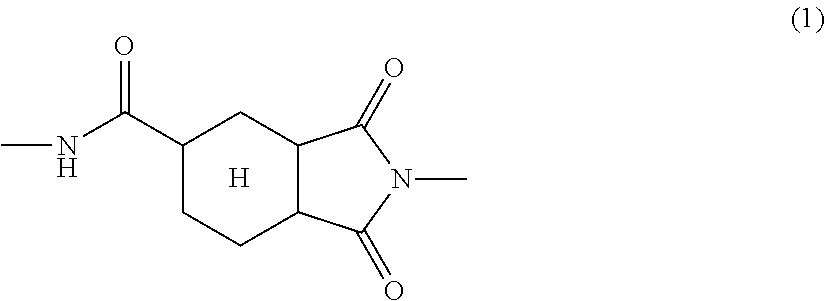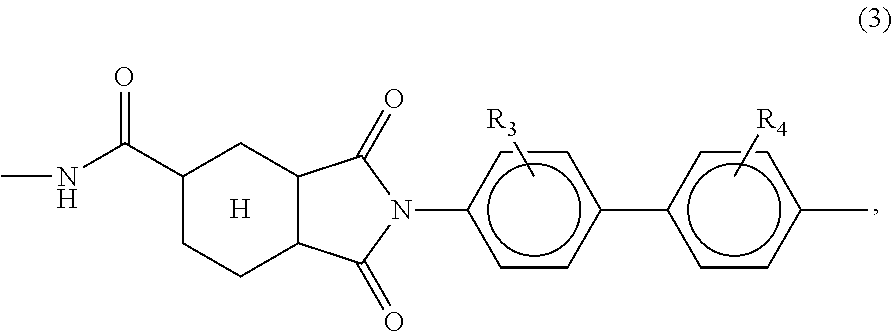Polyamideimide resin, as well as a colorless and transparent flexible metal-clad laminate and circuit board obtained therefrom
a technology of polyamideimide resin and metal-clad laminates, which is applied in the direction of synthetic resin layered products, metal-clad products, domestic applications, etc., can solve the problems of low elongation, lack of flexibility, and difficulty in applying colorless transparency to the use of transparent film substrates, etc., to achieve sufficient colorless and transparent properties, excellent heat resistance, and flexibility
- Summary
- Abstract
- Description
- Claims
- Application Information
AI Technical Summary
Benefits of technology
Problems solved by technology
Method used
Image
Examples
example 1
[0089]Into a reactor were placed 19.8 g (0.1 mol) of cyclohexanetricarboxylic acid anhydride, 26.4 g of o-tolidine diisocyanate and 0.11 g of potassium fluoride and the mixture was dissolved in 150 g of N-methyl-2-pyrrolidone and made to react at 80° C. to 150° C. for 8 hours in a nitrogen stream with stirring to give a transparent and viscous polyamideimide solution. Inherent viscosity of the resulting polyamideimide was 1.1 dl / g.
[0090]The polyamideimide solution prepared as such was coated on an electrolyzed copper foil of 18 μm thickness (trade name: “FWL”; manufactured by Furukawa Circuit Foil K. K.) using a knife coater so as to make the thickness after removal of the solvent 12.5 μm. After that, it was dried at 100° C. for 5 minutes to give a primarily dried flexible metal-clad laminate. Then the laminate subjected to a primary drying was wound on an aluminum tube having an outer diameter of 6 inches so as to make the coated surface outside, subjected to a stepwise thermal tre...
example 2
[0091]Into a reactor were placed 17.8 g (0.09 mol) of cyclohexanetricarboxylic acid anhydride, 1.7 g (0.01 mol) of terephthalic acid, 26.4 g (0.1 mol) of o-tolidine diisocyanate and 0.15 g of triethylene diamine and the mixture was dissolved in 150 g of N-methyl-2-pyrrolidone and made to react at 80° C. to 150° C. for 8 hours in a nitrogen stream with stirring to give a transparent and viscous polyamideimide solution. Inherent viscosity of the resulting polyamideimide was 1.0 dl / g.
[0092]The polyamideimide solution prepared as such was coated on an electrolyzed copper foil of 18 μm thickness (trade name: “FWL”; manufactured by Furukawa Circuit Foil K. K.) using a knife coater so as to make the thickness after removal of the solvent 12.5 μm. After that, it was dried at 10° C. for 5 minutes to give a primarily dried flexible metal-clad laminate. Then the laminate subjected to a primary drying was wound on an aluminum tube having an outer diameter of 6 inches so as to make the coated su...
examples 3 to 5
[0093]Polyamideimide solutions, flexible metal-clad laminates and films mentioned in Tables 1 and 2 were prepared by the same manner as in Examples 1 and 2 and various characteristics thereof were evaluated. The results are shown in Tables 1 and 2.
PUM
| Property | Measurement | Unit |
|---|---|---|
| light transmittance | aaaaa | aaaaa |
| thickness | aaaaa | aaaaa |
| thickness | aaaaa | aaaaa |
Abstract
Description
Claims
Application Information
 Login to View More
Login to View More - R&D
- Intellectual Property
- Life Sciences
- Materials
- Tech Scout
- Unparalleled Data Quality
- Higher Quality Content
- 60% Fewer Hallucinations
Browse by: Latest US Patents, China's latest patents, Technical Efficacy Thesaurus, Application Domain, Technology Topic, Popular Technical Reports.
© 2025 PatSnap. All rights reserved.Legal|Privacy policy|Modern Slavery Act Transparency Statement|Sitemap|About US| Contact US: help@patsnap.com



